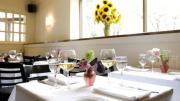Italian white eggplant is creamier and sweeter than its purple sisters. At Erbaluce in Boston’s Bay Village, chef Charles Draghi, A.L.B. ’92, roasts slices of it to a custard-like consistency, wraps them around fresh ricotta, then drapes the soft mound with warm dark chocolate ganache garnished with orange chunks soaked in saffron and honey.
This seasonal Amalfi Coast dessert is just one example of how Draghi lifts every rustic dish on his menu to a level of novel elegance. He is unafraid to create bold flavors and textures, but they never overwhelm the core nature of whatever is being served. And he typically does it without much help from olive oil, butter, or cream. Instead, sauces are made from vegetable essences and leftover cooking juices merged with herbs plus dustings and shavings of this and that. These methods give the food at Erbaluce—among the best Italian fare in Boston—clear, richly complex flavors without weighing the diner down.
Take the appetizer of razor clams from Duxbury, Massachusetts ($14). They are steamed gently in white wine, fennel, green peppercorns, garlic, and thyme. The broth, sopped up with crunchy toast, tasted of the earth and sea with a strong note of citrus. The roasted cauliflower florets (and delicious stems), seasoned with sage and Taleggio cheese ($11), are cooked to yield both crunchy and tender edges. They had the heft of meat, and were accented by plump cooked raisins and sharp-tasting capers.
The menu changes daily, depending on available ingredients. But it often features rabbit and veal, along with one of Draghi’s signature dishes: wild boar with wild Concord grapes and lavender sauce ($34).
We had a sole fillet entrée that came coiled around coral-colored lobster roe over fava beans that were surrounded by a tangy tomato sauce swirled into a yin-yang pattern ($27)—beautifully presented, like every dish here. The shiny, silver roasted whole mackerel ($22) came in a light gravy tinged with garlic and a salad of shredded kale and shaved white turnip slices with a sweet and sour nip. The accompanying fava beans, cooked until just tender, tasted faintly Moroccan, of cinnamon and roses.
The “Amalfitana” eggplant with dark chocolate was one of the best desserts we’d had in years, but so was the jiggly, pale panna cotta, surrounded by bright purple coulis made from Concord grapes; several luscious globes, like great wine, changed flavors in the mouth.
With food this riveting, diners need no distraction. Erbaluce’s two rooms are warmly spare, with off-white walls and white-clothed tables with candles in glass holders. The main dining area has a spacious feel, with a slightly vaulted ceiling from which hanging glass orbs offer soft, flattering light.
Draghi often steps out of the surprisingly calm kitchen to chat with patrons and sometimes to deliver chocolate truffles, on the house. The place has a slower, European feel; he says it is indeed popular with transatlantic diners. The chef spent his childhood summers in Piedmont (where the white Erbaluce grape is grown) and, lucky for us, he keeps close to those aesthetic and sensuous roots in all that he creates.









